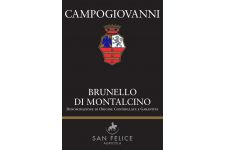
Campogiovanni
Campogiovanni
Biography
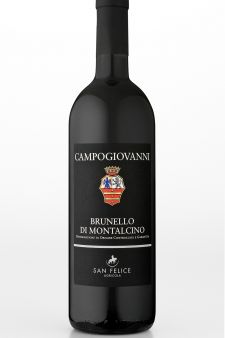
San Felice’s involvement in the Montalcino zone goes back to the early 1980s. At that time, the area of Brunello was witnessing signifi cant activity, but the area had not yet reached the world-class level of quality that it enjoys today. Our own fi rst bottles of Brunello di Montalcino were released to the market on January 1, 1985. The TENUTA CAMPOGIOVANNI is located on the southern slope of the Montalcino hill, near San Angelo in Colle. This particular area exhibits a complex of soils that produce some of the fi nest-quality Brunellos. In addition to our 20 hectares vineyards, there are 18 hectares of olive trees, woods, and fi elds, for an overall total of 65 hectares. Three separate parcels comprise the vineyards, at an elevation of approximately 300 metres. Of the 20 hectares of vines, 14 are dedicated exclusively to Brunello, and the remainder to a Rosso di Montalcino. In 1998 some Pugnitello vines were also planted. Most of the vines of Sangiovese are planted at a density of over 7,000 per hectare, trained to spurred cordon. Campogiovanni production is strongly focused on BRUNELLO and ROSSO DI MONTALCINO. 1990 saw the fi rst production of a Riserva, entitled IL QUERCIONE, made from fruit rigorously selected from the vineyard of the same name. This wine is only made in exceptional years. Campogiovanni Brunello fully merits its reputation as one of the great wines of this area. It has won, in fact, some of the most prestigious Italian and international wine awards, so much so that the 1990 and 2006 vintages were rated at the 7th and 4th place in the Wine Spectator’s “Top100’s”.






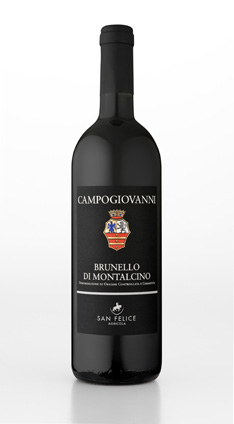
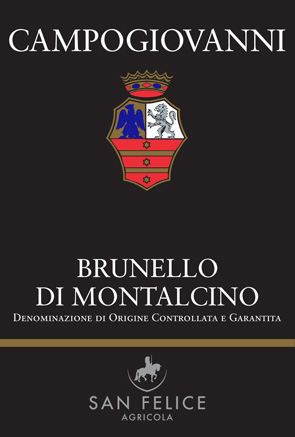

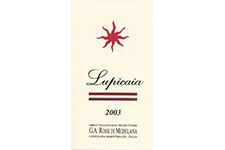
Castello del Terriccio
Castello del Terriccio
Biography
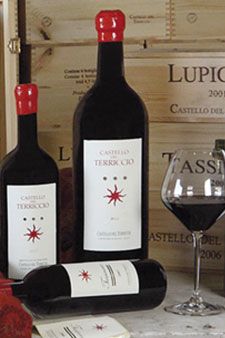
Things began to move at the Castello del Terriccio in 1975 when Gian Annibale Rossi di Medelana inherited the property. It is a very large estate with a castle, a hamlet, and many country farmhouses situated in a magnificent position in the hills of Castellina Marittima, a township on the shore of the Tyrrhenian Sea just a few miles away from Bolgheri. Rossi inherited the property from his great-uncle Serafini Ferri, who had taken in hand the estate in the first years after the Second World War, dedicating his time and energy to the cultivation of cereals; Rossi instead began to modify the crops, planting a part of the property to vineyards. Vineyards which were carefully planned and prepared before planting (with high vine density and limited production per vine) and only after a careful analysis of soil and climate. Studies which revealed that, just like nearby Bolgheri, there were real affinities with Bordeaux. Accordingly international varieties such as Cabernet Sauvignon, Merlot, and Petit Verdot substituted the local Sangiovese and Trebbiano and were an authentic revolution for Castellina Marittima. An idea and an inspiration which proved to be winning choices. The first wines were produced in 1986 and began immediately to interest both the media and connoisseurs. Lupicaia is the symbol of Terriccio, a classic Bordeaux blend (Cabernet Sauvignon, Merlot, and a touch of Petit Verdot); the Merlot and Cabernet are aged separately in barrique for 18 months and then, just as in Bordeaux, blended together in percentages which vary from year to year. The blend serves to bring out the maximum potential of the vintage and creates the possibility of producing, each year, a perfectly balanced wine, intense, supple, and, above all, long-lived. A wine which has won much recognition and many awards on an international scale. Another wine, named Castello del Terriccio, began to be produced in 2000 and is a blend of Syrah (another non-local variety which has given excellent results at Terriccio), Merlot, and other grapes. A wine which is complex, dense, and very spicy. Tassinaia rounds out the range, a Sangiovese with Merlot and PetitVerdot. But Terriccio is not solely a red wine estate, as its Rondinaia, a suave and balanced Chardonnay, demonstrates.
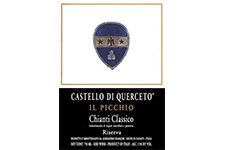
Castello di Querceto
Castello di Querceto
Biography
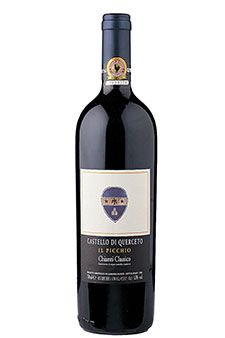
Castello di Querceto, for over a century, since long ago 1897, has belonged to the François family, of French origins, but in Tuscany since the 18th century when one of its members, a functionary of the house of the Hapsburgs of Lorrain, moved to Italy when the Grand Duchy came into their possession. The Castle is situated in the north-eastern part of Chianti Classico, in a small valley of the township of Greve in Chianti just a few miles from Florence; the vineyards and olive groves of the estate lie on the slopes of the valley at altitudes which range from 1300 to 1750 feet above sea level and are accordingly considered “high altitude”. The estate extends over 465 acres of property, 150 of which are planted to vines; the vineyards are located almost entirely around the castle and the estate headquarters, where, alongside the old estate buildings, a production unit of recent and modern construction has been erected with full respect for the tradition and the architectural style of the zone.
After two generations of activity, Alessandro François began an entirely new phase in the late 1970’s, one in which the estate was completely restructured with large investments involving both the viticulture and the transformation of the grapes into wine. Given the important expansion of the house in recent years, it was decided to plan for further development, a larger volume of production, and a rationalization of the entire production process.
Viticulture is conducted with an eye both to high quality grapes and to the ecological compatibility of cultivation practices. The philosophy of Querceto is based on the idea of maximizing character and personality through a thorough study of the characteristics of the single vineyard plots, with the aim of achieving all of the potential of the various grape varieties cultivated on the property. The most important offering is the Chianti Classico Riserva Il Picchio, 90% Sangiovese and the remaining part Canaiolo, a wine of notable structure and personality, very elegant in its impeccably Chianti style. It is an unmistakeably traditional wine, rich in noble tannins and a perfect match for red meat and game.
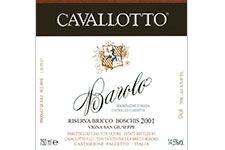
Cavallotto-Bricco Boschis
Cavallotto-Bricco Boschis
Biography
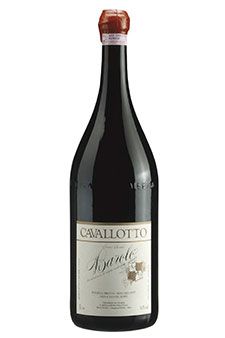
Situated at the outskirts of Castiglione Falletto in the Barolo appellation, on the Bricco Boschis hill, the Cavallotto estate extends over a surface of over 60 acres, 55 of which are planted to vineyards. The Cavallotto family are owner-cultivators for over five generations, and in 1948 brothers Olivio and Gildo Cavallotto were the first cultivators in the zone to commit themselves to the fermentation of their own grapes and the direct marketing of their own wines. Today it is Olivio’s children who run the property, using only the grapes of their own vineyards and taking maximum advantage of the many years of experience in the world of wine and the traditions of the family. The Cavallotto cellars are located amidst the vineyards of Bricco Boschis, on the eastern side, directly behind the old farmstead of the year 1800. In the central block, above ground, are located the large space for the fermentation of the grapes; here, the grapes are destemmed and pressed, then ferment and macerate in large stainless steel tanks with full control of the temperature. The aging period which follows for the Dolcetto, the Barbera, and the Barolo takes place in large casks of Slavonian oak located below the Bricco Boschis buildings in order to insure natural humidity and constant temperatures. The soil of Castiglione Falletto is particularly generous: it gives wines rich in alcohol, robust, and very long-lived. The geological characteristics of the various vineyard plots gives wines of different character in each and every parcel, though in a context of a constant search for maximum quality, the trademark of the estate. The informed use proper cellar techniques contributes to the production of important wines, first and foremost three different Barolo crus, all highly prized for their structure, ample aromas, and aging ability. Barolo Bricco Boschis, Barolo Riserva Bricco Boschis Vigna San Giuseppe, and Barolo Riserva Vignolo are considered among the top wines of Piedmont, award-winning bottles whose quality has been recognized and rewarded by a large part of the national and international wine press.
The range of estate wines, however, is a large one and includes many of the native grape varieties of Piedmont, from which Dolcetto d’Alba, Barbera d’Alba, Nebbiolo Langhe, Freisa Langhe, Grignolino Piemonte, Pinot Langhe, and Chardonnay Langhe are all produced.
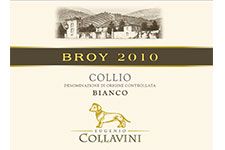
Collavini
Collavini
Biography
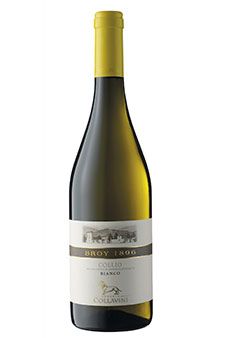
The Collavini family’s involvement in wine began in 1896, when the founder of the dynasty, Eugenio Collavini, began to supply the better families of Udine with his wines. But the magic moment in the development of the firm came in the 1970’s when his descendent, Manlio Collavini, decided to invest sizeable capital in modern and functional plants and improve both the efficiency of the cellars and the quality of the wines. The move was rewarded with immediate success thanks to Grigio, a sparkling wine from Prosecco and Chardonnay grapes which won widespread and immediate popularity. Doubled with the creation of a sparkling Ribolla Gialla. With the acquisition and renovation, in 1980, of a 16th century mansion in Corno di Rosazzo, this enterprising producer of Friuli not only found a prestigious home for his family but also cellars in which he could concentrate production. And it was then that the qualitative leap of the firm took place, with a far-reaching and comprehensive program which included long-term relationships with the supplier of grapes, and modernization of the cellar technology based on soft pressing and temperature-controlled fermentation. Currently, with 430 acres of proprietary vineyards and an annual production of 1.5 million bottles, Manlio Collavini’s company is one of the most efficient and important of Friuli. This is due to the care and attention with which he has always given both to the volume wines and to the higher level offerings in his line, and to the interest which has always been given to experimentation in the cellars: not only traditional techniques, such as the drying of the grapes, but also new concepts such as the freezing of the grapes, reverse osmosis and so forth. For him, wine is much more than a drink: a conviction which has driven him, as a member of Parliament, to improve wine legislation as well. The most brilliant results, however, of his public activities have been to succeed in baptizing the streets of his home township, Corno di Rosazzo, with the name of the native grape varieties: the address of his house, in fact, is Via Ribolla Gialla. Assisted by his wife Anna and his sons Luigi and Giovanni, he also relies on the cellar work of winemaker Walter Bergnach. The finest achievement has been a white, Broy, a Collio appellation wine which blends Tocai, Chardonnay, and Sauvignon, along with two red wines: Forresco, a Collio blend of Refosco dal Peduncolo Rosso, Refosco di Faedis, and Pignolo, and Dal Pic, a Collio Merlot from one of the great international varieties.

